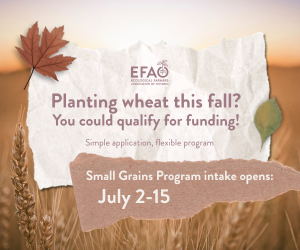High and then low
THE BENEFITS OF MINIMUM PRICE PROTECTION IN 2015
BETWEEN 2012 AND November 2014, agricultural commodity prices were on a roller coaster ride. During 2012, corn and soybean commodity futures prices hit all-time record highs. Wheat futures price highs also came in well into their 90th plus percentile of historical prices.
Interestingly, most of the highest prices in 2012 occurred during the late third and fourth quarter of the year. This is very counter seasonal. 2013 and 2014, year-to-date, have been very “seasonal” in nature with the annual highs for corn, soybeans, and wheat futures occurring around the April-July timeframe and the futures lows (very much lower than the 2012 highs) occurring some- where between September and October.
Having gone through these very different years, even the most careful commercial crop producer has to be asking the question, “how do I approach the marketing of my 2015 crops?”
Here are some thoughts to guide you. During 2012, there were major production problems in both North and South America. It took those two production shortfalls to drive commodity prices to their 2012 all-time highs. Currently, the United States Department of Agriculture (USDA) tell us that the world’s crop reserves have grown, having been replenished during 2013 and 2014. It stands to reason that in 2015 it will take very severe production problems around the world to drive commodity prices anywhere near 2012 levels. Not impossible, but still rather unlikely.
WHAT CAN YOU DO ABOUT YOUR MARKETING?
Same message — back to basics. Following are three pillars of commodity marketing.
- Estimate your farm’s Cost of Production (COP): As the year’s prices unfold, achieving a price higher than your crop COP is the minimum objective
- Understand the seasonal tendency in commodity futures prices.
- Develop selling plans for each of your crops and watch for marketing opportunities that allow you to achieve your target prices.
Seasonality suggests that, in average price years, the best commodity futures prices (in the annual cycle) will occur sometime between April and August. In any given year, commodity futures prices may not get as high as your plan requires — especially if it is a “surplus” year, i.e. a year when North American or world production exceeds estimated demand and “reserves” are growing.
MINIMUM PRICE PROTECTION
If you are proficient with options on futures, sometime during the seasonal high period consider using ‘put options’ (or a minimum price contract with a buyer if available) to defend a minimum futures price. If you are not proficient, consider a workshop to learn about them or get a marketing advisor. Then, watch for higher futures prices if they occur and opportunities in basis.
Using ‘puts’ on commodity futures, or a ‘minimum price contract’ with a grain buyer, will eliminate the possibility of having to accept any price below your put option price or minimum price contract price — after deducting any costs and basis.
To illustrate, consider a hypothetical corn grower who in January is concerned that corn futures prices for November delivery may be lower at harvest time. Corn futures are currently $5.60/bushel (bu). The grower buys $5.60 put options on the December corn futures and spends 30 cents a bushel to do so. The scenarios at right show the possible outcomes.
In scenario 1, the December corn futures fall to $3.60/bu at harvest time. Keeping basis the same (- 20 cents a bushel) to enable us to examine only the effect of futures, the “cash” price for corn is now $3.40/bu. The $5.60/bu put option will pay out $1.70/bu (i.e. $2.00/bu less the 30 cent/bu cost of purchase). Our corn seller will overall get a minimum price of $5.10/bu. This is much better than getting the $3.40/bu harvest cash price.
SCENARIO 1: PUT OPTION HEDGE WHEN COMMODITY FUTURES FALL AT HARVEST TIME.
| January | ||||
| Futures | $5.60 | Buy Put Option, Srike Price | $5.60 | |
| BASIS | ($0.20) | Option Cost | ($0.30) | |
| Fixed Forward | $5.40 | Net Futures Protected | $5.30 | |
| October | ||||
| Futures Now | $3.60 | Gain on Put Option | $2.00 | |
| BASIS | ($0.20) | Less Option Cost | $1.70 | |
| Est. Cash Price | $3.40 | Final net Futures price received | $5.30 | |
| Less estimated BASIS | ($0.20) | |||
| Price to Option hedger | $5.10 |
In scenario 2, the December corn futures rise to $7.50/bu at harvest time. Keeping basis at – 20 cents/bu, the harvest cash price is now $7.30/bu. Our corn seller will not need the put option which ends up being a 30 cent per bushel cost. Nevertheless, the corn seller gets a net price of $7.00/bu for their corn.
SCENARIO 2: PUT OPTION HEDGE WHEN COMMODITY FUTURES RISE AT HARVEST TIME.
| January | ||||
| Futures | $5.60 | Buy Put Option, Srike Price | $5.60 | |
| BASIS | ($0.20) | Option Cost | ($0.30) | |
| Fixed Forward | $5.40 | Net Futures Protected | $5.30 | |
| October | ||||
| Futures Now | $7.50 | Gain on Put Option | $0.00 | |
| BASIS | ($0.20) | Less Option Cost | ($0.30) | |
| Est. Cash Price | $7.30 | Final net Futures price received | $7.20 | |
| Less estimated BASIS | ($0.20) | |||
| Price to Option hedger | $7.00 |
CONCLUSIONS
Using a minimum price contract or a put option protects you from a drop in the commodity futures component of your crop price while allowing you to benefit if prices subsequently rise. However, it is important to note that put options have a cost (i.e. the premium you have to pay). Given the pricing challenges we may have to face in more difficult marketing years, this tool is probably a good addition to the grain and oilseeds marketer’s toolkit. •
Victor Aideyan is president/CEO of HISGRAIIN Commodities Inc. He utilizes his 20 years of experience in commodity marketing to help agricultural commodity producers better understand elements of the business planning process such as profit drivers and risk management.


















